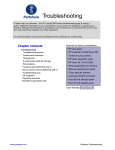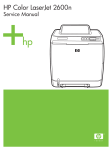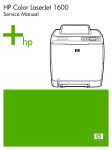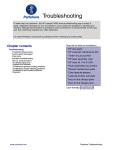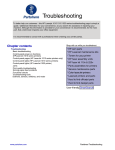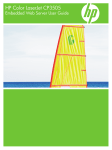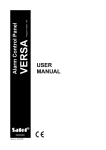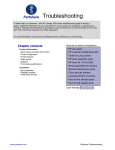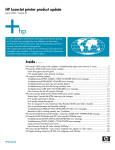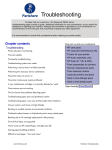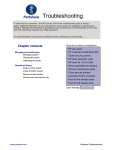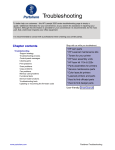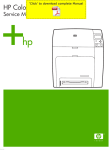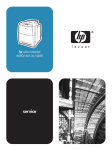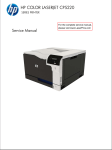Download HP Color LaserJet 2600n Service Manual
Transcript
Troubleshooting To better help our customers - this HP Laserjet 2600n series troubleshooting page is simply a guide / additional information for your convenience, as you search for assistance in repairing your machine. Although this information is provided for your convenience it is recommended, for the most part, that a technician inspects your office equipment. It is recommended to consult with a professional when ordering your printer part(s). Chapter contents Troubleshooting Troubleshooting process Clearing jams Print problems Functional tests (SERVICE ONLY) Service mode functions (SERVICE ONLY) Troubleshooting tools HP Toolbox Diagnostic resources Repetitive image defect ruler Firmware and software updates Shop with us while you troubleshoot. * HP oem parts * HP LaserJet maintenance kits .........printer * Toners for your * HP fuser assembly units * HP fuser kit 110v & 220v * Parts assemblies for printers * Service maintenance parts * Color laserJet printers * LaserJet printers and parts * Hard to find officejet parts * Hard to find deskjet parts User-friendly SmartSearch! www.partshere.com Partshere Troubleshooting Troubleshooting process Use the troubleshooting checklist to solve issues with the device. Troubleshooting checklist Follow the steps below when trying to solve a problem with the device. Table 6-1 Troubleshooting checklist Step number Verification step Possible problems Solutions 1 Is the power on? No power due to failed power source, cable, switch, or fuse. 1 Verify that the device is plugged in. 2 Verify that the power cable is functional and that the power switch is on. 3 Check the power source by plugging the device directly into the wall or into a different outlet. 4 Test the outlet or connect another device to the outlet to verify that the outlet is functioning. When the device is connected to a grounded power source, the control panel shows HewlettPackard with both the Ready and Attention lights blinking. The control panel will then display Initializing and then Ready, at which time only the green light will be on. 2 Does Ready appear in the device control panel? Control panel shows an error. See Control panel messages for a list of common messages that will help you correct the error. Control panel displays an error message. See Control panel messages for a list of common messages that will help you correct the error. Media does not move smoothly through the device paper path. Clean the paper path. Poor print quality. For information, see General print quality issues. Software is not installed correctly or an error occurred during software installation. Uninstall and then reinstall the device software. Verify that you are using the correct installation procedure and the correct port setting. The cable is not connected correctly. Reconnect the cable. An incorrect driver is selected. Select the proper driver. Other devices are connected to the USB port. Disconnect the other devices and try again to print. There is a port driver problem in Microsoft Windows. Uninstall and then reinstall the device software. Verify that you are using the correct installation procedure and the correct port setting. The control panel should function without error messages. 3 Do information pages print? Print a Configuration page. 4 Does the device print from the computer? Connect the network cable or USB cable to the device and the computer. Use a word-processing application to send a print job to the device. If the error persists, see the support flyer that came in the device box. www.partshere.com Partshere Troubleshooting Clearing jams This section contains information about clearing jams. Paper path Figure 6-1 Paper path For paper path sensor locations, see Figure 4-12 Paper pickup and feed system. www.partshere.com Partshere Troubleshooting Common causes of paper jams Occasionally, paper or other print media can become jammed during a print job. Some causes include the following events: Cause Solution The input trays are loaded improperly or overfilled. Remove any excess paper from the input tray. Make sure that the paper does not exceed the maximum stack height mark in the input tray. Tray 2 or optional Tray 3 is opened during a print job. Make sure that Tray 2 or optional Tray 3 is closed. Too many sheets accumulated in the output area or sheets blocked the output area. Remove any accumulated sheets and clear the output area. For information about clearing jams from the output area, see Output jams. The print media that is being used does not meet HP specifications. Use only paper that meets HP specifications. For more information, see the HP LaserJet Printer Family Print Media Guide or go to http://www.hp.com/support/ljpaperguide. The environment in which the print media was stored is too humid or too dry. Make sure that the printer environment is within humidity specifications. For more information, see Printing and storage environment. A supply item is installed incorrectly, causing repeated jams. Verify that all print cartridges and the ETB are correctly installed. Print media is skewed. Input tray guides are not adjusted correctly. Adjust input tray guides so they hold the print media firmly in place without bending it. NOTE Do not fan paper. Fanning can create static electricity, which can cause the paper to stick together. Print media is binding or sticking together. Remove paper, flex it, rotate it 180 degrees, or flip it over. Reload paper into the input tray. Print media is removed before it settles into the output bin. Reset the printer. Wait until the page completely settles in the output bin before removing it. Print media is in poor condition. Replace the paper. Print media is not picked up by the internal rollers from Tray 2 or Tray 3. Remove the top sheet of paper. If the paper is heavier than 163 g/m2 (43 lb), it may not be picked from the tray. Print media has rough or jagged edges. Replace the paper. Print media is perforated or embossed. This paper does not separate easily. Feed single sheets from Tray 1. The printer supply items have reached the end of life. Print media was not stored correctly. www.partshere.com Check the printer control panel for messages prompting a replacement of supplies, or print a supplies status page to verify the remaining life of the supplies. Replace the print media. Print media should be stored in the original packaging in a controlled environment. Partshere Troubleshooting Where to look for jams Jams can occur in these locations: Ŷ Inside the printer Ŷ In input areas Ŷ In the output area Ŷ Paper path The following illustration identifies the stages when jams can occur. Figure 6-2 Jam locations and stages 1 Pickup stage 2 Feeder stage 3 Transfer/feed stage 4 Fusing/delivery stage www.partshere.com Partshere Troubleshooting Find and remove the jam by using the instructions on the following pages. If the location of the jam is not obvious, first look inside the printer. Loose toner might remain in the printer after a jam. This problem should resolve itself after a few sheets have been printed. Each section below corresponds to an area where a paper jam could occur. Use the following procedures to clear the jam. In all cases, grasp the jammed paper by both corners and pull slowly to remove the paper. Jams inside the printer Use the following instructions to clear jams from inside the printer. CAUTION Jams in this area might result in loose toner on the page. If you get toner on your clothes or hands, wash them in cold water. (Hot water will set the toner into the fabric.) 1 Open the front door. CAUTION Do not place anything on the transfer belt, which is located on the inside of the front door. Otherwise, the printer may be damaged, adversely affecting print quality. www.partshere.com Partshere Troubleshooting 2 Carefully grasp the jammed paper by both corners and pull slowly to remove the paper. 3 Close the front door. Input jams Tray 1 If the jammed paper is easily accessible from the outside of the printer, grasp both edges of the paper and firmly pull to remove. Otherwise, follow the directions for Tray 2. www.partshere.com Partshere Troubleshooting Tray 2 Open the front door of the printer and remove paper as indicated on the jam instruction label, located on the interior right side of the printer. Input jams are indicated on the label with the number 3. Figure 6-3 Tray 2 input jam label Output jams Jams in the top bin CAUTION Jams in these areas might result in loose toner on the page. If you get toner on your clothes or hands, wash them in cold water. (Hot water will set the toner into the fabric.) 1 Carefully grasp the jammed paper by both corners and pull slowly to remove the paper from the top bin. www.partshere.com Partshere Troubleshooting 2 Open and close the front door. Pickup delay jam The printer performs the retry control, which executes the pickup operation three times, to retrieve the pickup delay jam caused by the pickup error. When the registration paper sensor (SR1) does not detect the leading edge of the paper within approximately 2.5 seconds (4.5 seconds for optional cassette) after the pickup solenoid (SL1) is turned ON, the CPU tries to pick up the paper three times. Pickup stationary jam The CPU determines the pickup stationary jam when the registration paper sensor (SR1) does not detect the trailing edge of the paper within approximately 8.6 seconds after it detects the leading edge. Delivery delay jam The CPU determines the delivery delay jam when the fuser delivery paper sensor (SR4) does not detect the leading edge of the paper within approximately 6.6 seconds after the registration paper sensor (SR1) detects the leading edge. Wrapping jam The CPU executes the wrapping jam detection after it assesses no delivery delay jam. The CPU determines the wrapping jam, when the fusing delivery paper sensor (SR4) detects the paper absence before the time equivalent to paper passage of its length minus 40 mm (1.6 inches) after the SR4 detected the leading. Delivery stationary jam The CPU executes the delivery stationary jam detection after it assesses no wrapping jam. The CPU determines the delivery stationary jam, when the fuser delivery paper sensor (SR4) detects the paper presence after the time equivalent to paper passage of its length plus 50 mm (1.9 inches) from when it detected the trailing edge. Start-up residual paper jam The CPU determines the start-up residual paper jam when either the pre-fuser paper sensor (SR5) or the fuser delivery paper width sensor (SR4) detects the paper when the initial rotation is started. www.partshere.com Partshere Troubleshooting Door open jam The CPU determines the door open jam, when either the pre-fuser paper sensor (SR5) or the fuser delivery paper width sensor (SR4) detects paper when a door open is detected. www.partshere.com Partshere Troubleshooting Print problems Getting information The following sections contain information about control panel messages, error reports, and available service menus. Control panel messages The majority of the control-panel messages are intended to guide the user through typical operation. The control-panel messages indicate the status of the current operation, and include a page count on the second line of the display, if appropriate. When the device is printing data, control-panel messages indicate this status. In addition, alert messages, warning messages, and critical error messages indicate situations that might require some action. Alert and warning messages Control panel message Description Recommended action Device error An internal error occurred in the device. Press Door open The printer door is open. The door must be closed before printing can continue. Engine comm. The device experienced an internal communication error. This is a warning message only. Job output might be affected. Invalid driver You are using the incorrect printer driver. Reselect the printer driver appropriate for your device. Invalid entry Invalid data or response. Correct the entry. Jam in A paper jam has occurred in Tray 2. Clear the jam, and then press the (SELECT) button on the control panel. A paper jam has occurred in Tray 3. Clear the jam, and then press the (SELECT) button on the control panel. A paper jam has occurred in the print path. Open the door and clear the jam. Then (SELECT) to resume the job. Press error tray 2 Jam in tray 3 Jam in press the panel. print paper path Jam in A paper jam has occurred in the print path. Jam in Output bin Open the door and clear the jam. Then press the panel. Cartridge area (SELECT) button on the control (SELECT) button on the control A paper jam has occurred in the output area. Clear the jam, and then press the (SELECT) button on the control panel. Load paper The HP Color LaserJet 2600n printer is out of paper. Please load specified paper type into the tray indicated. Load Tray X The printer is processing job, but the tray indicated is empty. Please load specified paper type and size into the tray indicated. [TYPE] [SIZE] www.partshere.com Partshere Troubleshooting Control panel message Description Recommended action Manual feed The printer is waiting for paper in the tray indicated. Load the paper as indicated. The device memory has been almost completely filled. Allow the device to finish the job, or press Press Memory is low Press (SELECT) to cancel the job. Break the job into smaller jobs that contain fewer pages. Misprint The printed pages have been incorrectly placed on the paper. To continue, press the on the control panel. The print engine has failed to pick up a piece of media. In Tray 1, verify that the media was inserted far enough into the tray. In Tray 2 or optional Tray 3, verify that the paper-length guide is in the correct position for the media size that you are using. Press No paper pickup Press (SELECT) button Reload the media in the input tray and press Unexpected size (SELECT) to continue the job. Unexpected paper size error. The media size loaded in the tray does not match the media size configured for the tray. Verify that the print settings are set to the specified media in the tray. Control panel message Description Recommended action 50.1 Fuser Error The device has experienced an internal hardware error. Turn off the device, wait at least 25 minutes, and then turn on the device. 50.1 Fuser Error—low temperature If a surge protector is being used, remove it. Plug the device directly into the wall socket. Use the power switch to turn on the device. in tray X Critical error messages 50.2 Fuser Error 50.3 Fuser Error 50.3 Fuser Error—slow fuser 50.2 Fuser Error—high temperature If this does not clear the error, replace the fuser. 51.20 Error The device has experienced an internal hardware error. 51.21 Error 51.20 Error—black scanner error Turn off the power by using the power switch, wait at least 30 seconds, and then turn on the power and wait for the device to initialize. 51.22 Error 51.21 Error—cyan scanner error 51.23 Error 51.22 Error—magenta scanner error 51.23 Error—yellow scanner error If a surge protector is being used, remove it. Plug the device directly into the wall socket. Use the power switch to turn the device on. Laser scanners are not replaceable. Replace the engine. 55.1 Error www.partshere.com DC controller error. The device has experienced an internal hardware error. Turn off the power by using the power switch, wait at least 30 seconds, and then turn on the power and wait for the device to initialize. Partshere Troubleshooting Control panel message Description Recommended action If a surge protector is being used, remove it. Plug the device directly into the wall socket. Use the power switch to turn the device on. Check the engine (DCC) firmware version. Update if needed. Replace the DCC if a firmware upgrade does not resolve the issue. 57 Fan Error The device has experienced a problem with its internal fan. Turn off then on Turn off the power by using the power switch, wait at least 30 seconds, and then turn on the power and wait for the device to initialize. The fan is not replaceable. Replace the engine. Supplies messages Control panel message Description Recommended action 10.000x Supply error E-label cannot be read or print cartridge is not properly installed. 1 Reinstall print cartridge. 2 Turn on the printer. 3 If the problem is not solved, replace the cartridge. 10.0000 = Black print cartridge 10.0001 = Cyan print cartridge 10.0002 = Magenta print cartridge 10.0003 = Yellow print cartridge 10.100x Supply error A print cartridge is missing. alternates with 10.1000 = Black print cartridge Reinstall 10.1001 = Cyan print cartridge The supplies gauge will display the consumption levels of print cartridges. 10.1002 = Magenta print cartridge Install the correct print cartridge. 10.1003 = Yellow print cartridge HP supplies installed One of the following messages may display: The printer transitioned from having one or more non-HP supplies to having all HP supplies installed. No action required. The <color> print cartridge not installed correctly. Reinstall the <color> print cartridge. The out threshold has been reached. The supply must be replaced before printing can continue. Incorrect black Incorrect cyan Incorrect magenta Incorrect yellow One of the following messages may display: Install black cartridge Install cyan cartridge www.partshere.com Partshere Troubleshooting Control panel message Description Recommended action Multiple supplies are not installed. Install correct print cartridges. Install magenta cartridge Install yellow cartridge The supplies gauge will display the consumption levels of print cartridges. Install supplies The supplies gauge will display the consumption levels of print cartridges. One of the following messages may display: A non-HP <color> cartridge is installed. NOTE Any printer repair required as a result of using a non-HP or unauthorized supply is not covered under warranty. Non HP black installed Non HP cyan To use this cartridge, override by pressing the installed (SELECT) button on the control panel. Non HP magenta installed Non HP yellow installed alternates with To accept Press Non HP supply in use A non HP (cloned or refilled) supply has been installed that is not made by HP and was overridden. If you believe you purchased an HP supply, please call the HP fraud hotline at 1-877-219-3183. Service or repairs required as a result of using non-HP supplies is not covered under HP warranty. The <color> print cartridge low threshold has been reached. For more information go to the HP Color LaserJet 2600n toolbox and click Supplies Status. To order supplies online, click Order Supplies. alternates with Ready The supplies gauge will display the consumption levels of print cartridges. One of the following messages may display: Order black cartridge, Order cyan cartridge, Order magenta cartridge, or Order yellow cartridge www.partshere.com Partshere Troubleshooting Control panel message Description Recommended action Multiple supplies are low. For more information go to the HP Color LaserJet 2600n toolbox and click Supplies Status. To order supplies online, click Order Supplies. The out threshold has been reached. The supply must be replaced before printing can continue. The out threshold has been reached. The supply must be replaced before printing can continue. Supply override in use. The user has decided to continue printing beyond the out point. A supply is low and using Override may result in unsatisfactory print quality. Replace the supply that is low. Supply override in use. The user has decided to continue printing beyond the out point. A supply is low and using Override may result in unsatisfactory print quality. Replace the supply that is low. alternates with Ready The supplies gauge will display the consumption levels of print cartridges. ORDER SUPPLIES alternates with Ready The supplies gauge will display the consumption levels of print cartridges. One of the following messages may display: Replace black cartridge Replace cyan cartridge Replace magenta cartridge Replace yellow cartridge Replace Supplies The supplies gauge will display the consumption levels of print cartridges. Replace supplies Override in use alternates with Ready The supplies gauge will display the consumption levels of print cartridges. Replace supply. Override in use alternates with Ready The supplies gauge will display the consumption levels of print cartridges. www.partshere.com Partshere Troubleshooting Control panel message Description Recommended action Unauthorized A new supply has been installed that is not made by HP and was overridden. If you believe you purchased an HP supply, please call the HP fraud hotline at 1-877-219-3183. Service or repairs required as a result of using non-HP supplies is not covered under HP warranty. A new supply has been installed that is not made by HP. One of these four messages is displayed until an HP supply is installed If you believe you purchased an HP supply, please call the HP fraud hotline at 1-877-219-3183. Service or repairs required as a result of using non-HP supplies is not covered under HP warranty. supply in use alternates with Ready The supplies gauge will display the consumption levels of print cartridges. One of the following messages may display: Unauthorized yellow Unauthorized magenta or (SELECT) is pressed. Unauthorized cyan To continue printing, press (SELECT). Unauthorized black Status messages Status messages are used to inform the user of the current state of the system. Status messages do not require user action or acknowledgement, and are for information only. Control panel message Description Recommended action Calibrating... The printer is calibrating. No action is required. Cleaning... The printer is in cleaning mode. No action is required. Status log only messages The following messages are not displayed on the control panel. They are printed on the Status log. Table 6-2 Status log only messages Error log code Description 54.06 Color density sensor error 54.10 Color plane registration sensor(s) error 54.11 Yellow density out of range 54.12 Magenta density out of range 54.13 Cyan density out of range 54.14 Black density out of range www.partshere.com Partshere Troubleshooting Reports menu The following reports are available from the Reports menu. Ŷ Demo Page—used to help market the product at retail stores Ŷ Menu structure—highlights the control panel menu layout Ŷ Config report—details all default device settings including network configuration and information Ŷ Supplies Status—provides information on each of the print cartridges, including estimated pages remaining, cartridge serial number, and pages printed www.partshere.com Partshere Troubleshooting Configuration page The Configuration page lists the current settings and properties of the printer. You can print a Configuration page from the printer or HP Toolbox. To print the Configuration page from the printer, see Configuration page. Table 6-3 Configuration page 1 Product information. This section contains the following basic information about the printer: Ŷ Product name Ŷ Formatter number Ŷ Serial number Ŷ Service ID Ŷ Firmware version Ŷ Maximum print resolution 2 Memory. This section lists memory-related information, such as the total memory that is installed. 3 Paper settings. This section lists information about the media type for each tray and about the type settings for all the media that the printer supports. 4 Page counts. This section lists the total number of pages printed, the number of color pages printed, and information about paper jams. www.partshere.com Partshere Troubleshooting 5 DC controller version. This section lists the DC controller version. 6 USB settings. This section contains information for the USB setting options. 7 Ŷ U=0 Hi speed Ŷ U=4 Full speed Ŷ U=5 Full speed auto switched from hi speed Extended print modes enabled. The following list contains the options for enabling extended print modes. Ŷ DM=0 Default setting Ŷ DM=1 Extended print mode enabled 8 Status log. This section contains information about printer errors, including an error code and the page count at which the error occurred. For a list of status log messages, see Table 6-5 Status log messages. 9 Paper types. This section contains information about paper types that can be configured by the user. The default setting is Plain. 10 Network settings. This section contains the following network information about the printer. 11 Ŷ Host name Ŷ Hardware address Ŷ LInk settings Ŷ IP address information Ŷ IP subnet mask Ŷ IP default gateway Ŷ WINS configuration information Ŷ DHCP server and lease time information Ŷ Preferred WINS server information Ŷ mDNS name Product settings. This section lists the following information that is gathered during software installation: Ŷ Language Ŷ Company name Ŷ Jam recovery settings (if set to ON, the last page will reprint if there is a paper jam) Ŷ I/O timeout information (default is 120 seconds) NOTE The color bars on the sides of the Configuration page represent 100%, 75%, 50%, and 25% coverage. www.partshere.com Partshere Troubleshooting Supplies Status page The Supplies Status page lists the remaining life of HP print cartridges. It also lists the estimated pages remaining, number of pages printed, and other supplies information. You can print a Supplies Status page from the printer or the HP Toolbox. To print the Supplies Status page from the printer control panel 1 Press (LEFT ARROW) or 2 Press (SELECT). 3 Press (LEFT ARROW) or 4 Press (SELECT) to print the Supplies Status page. (RIGHT ARROW) to select the Reports menu. (RIGHT ARROW) to select Supplies Status. NOTE Supplies information is also available through the HP Toolbox. Table 6-4 Supplies Status page 1 Print cartridge area 2 Ordering information 3 Return and recycling information Status log The status log for this printer is located on the Configuration page and lists the last five events. For more information, see Configuration page. www.partshere.com Partshere Troubleshooting Table 6-5 Status log messages Error log code Description 10.0000 Black e-label error 10.0001 Cyan e-label error 10.0002 Magenta e-label error 10.0003 Yellow e-label error 10.1000 Black e-label missing 10.1001 Cyan e-label missing 10.1002 Magenta e-label missing 10.1003 Yellow e-label missing 10.3000 Non-HP black 10.3001 Non-HP cyan 10.3002 Non-HP magenta 10.3003 Non-HP yellow 13.0000 Paper jam, Tray 1 area 13.0001 Paper jam, Tray 2 area 13.0002 Paper jam, Tray 3 area 13.0003 Paper jam, registration drum area 13.0004 Paper jam, drum fuser area 13.0005 Paper jam, fuser output area 20.0000 Memory out 21.0000 Video under run 50.1000 Low temperature fuser error 50.2000 Slow fuser error 50.3000 High temperature fuser error 50.4000 Fuser heater wire failure 50.5000 Fuser low temperature subtherm failure 50.6000 Fuser high temperature subtherm failure 52.0000 Scanner error, black laser failure 52.0100 Scanner error, cyan laser failure 52.0200 Scanner error, magenta laser failure 52.0300 Scanner error, yellow laser failure 54.0600 Density sensor error 54.1000 Color plane registration sensor error 54.2800 Sensor density contaminated www.partshere.com Partshere Troubleshooting Table 6-5 Status log messages (continued) Error log code Description 54.2801 Sensor color plane registration contaminated 55.0000 Engine comm fatal error 55.0001 Engine comm critical error 55.1000 DC controller memory error 57.0000 Fan motor error 57.0001 Fan cartridge failure 59.0000 Paper path/ETB rotation failure 59.0001 Paper path/ETB ramp up failure 101.0000 Color plane registration error 102.0000 DMAX calibration error 103.0000 DHALF calibration error Service menu settings The service menu is used to calibrate, restore factory default settings, and clean the print paper path. The following service menu items are available: Ŷ Restore defaults—used to reset all customer-accessible menu settings back to the factory default settings (except language) via the control panel or software NOTE This service menu item does not reset factory-settable settings, including formatter number, page counts, factory paper settings, language, and so on. Ŷ PowerSave—used to configure the amount of idle time before the engine enters sleep mode Ŷ Cleaning mode—used to remove dust and toner from the print paper path Secondary service menu The secondary service menu is intended for use by manufacturing engineers, service engineers, developers, and support personnel. This menu provides options to perform various tests and print out special reports. www.partshere.com Partshere Troubleshooting The following secondary service menu items are available: Ŷ Service Reports—used to print out a continuous configuration report, translation report, and error report Ŷ USB Speed—enables or disables the ability for the printer to operate in high speed. The following USB Speed setting options are available: Ŷ Auto Ŷ Hi speed Ŷ Full speed Ŷ Display test—verifies that all of the characters on the display function correctly by allowing you to manually scroll through the characters Ŷ Clean ETB—used to clean the ETB Ŷ Calibrations Ŷ All Cals Ŷ CPR Cal Ŷ DMAX/DHALF Cal Ŷ DHALF Only Cal Ŷ Test Page To enter the secondary service menu, use the following procedure: 1 Confirm that the device is in a Ready state. 2 Press the button (SELECT) to enter the main menu system. 3 Press the button (LEFT ARROW) and the 4 Press the button (SELECT) to confirm 2ndary Service. 5 Press the (LEFT ARROW) button and service menu. button (CANCEL JOB) simultaneously. button (RIGHT ARROW) to navigate to the secondary Printed image quality problems Improving print quality Use the print-quality settings in the HP Toolbox to improve print-quality problems. To access the HP Toolbox, see HP Toolbox. The following menus contain paper type, print mode, and print-quality settings. To restore the default settings, open the HP Toolbox and click Device Settings. Then click Settings, Service, and in Restore Factory Settings, click Restore. Paper Types menu The purpose of this menu is to specify the print mode for paper types which are non-specific. To make changes in the Paper Types menu, make the desired selections and click Apply. www.partshere.com Partshere Troubleshooting Table 6-6 Print modes for paper types Print Modes for paper types Weight Default media types Normal mode 75-89 g/m2 Plain, color, preprinted, prepunched, recycled Transparency Transparencies Labels Labels Light 75-89 g/m2 Light Heavy 90-105 g/m2 Heavy Cardstock 106-163 g/m2 Cardstock, bond Light Glossy 75-105 g/m2 Light Glossy Glossy 106-120 g/m2 Glossy Heavy Glossy 121-163 g/m2 Heavy Glossy HP Tough paper HP Tough paper Envelope Envelopes Print Modes menu Under the Print Modes menu in HP Toolbox, each Media Type will have a Fusing menu, a Transfer menu, and a Toner menu. Select a setting for each menu item. Media types are listed with the plain papers together, glossy papers together, and special media at the end. To make changes in the Print Modes menu, make the desired selections and click Apply. Table 6-7 Extended print modes HP Toolbox extended print mode Printer adjustment Change in printer setting Paper curl Fusing adjustment Reduced fuser temperature for less negative paper curl Heavy coverage Fusing adjustment Increased fuser temperature for less positive paper curl with heavy toner coverage Toner offset Fusing adjustment Reduced fuser temperature for less toner offset Flap sealing Fusing adjustment Reduced fuser temperature to keep envelope flaps from sealing Less fusing Fusing adjustment Reduced fuser temperature More fusing Fusing adjustment Increased fuser temperature Dry paper Transfer adjustment Increased transfer bias for high resistivity paper Humid paper Transfer adjustment Decreased transfer bias for high resistivity paper Rough paper Transfer adjustment Increased transfer bias for high resistivity paper www.partshere.com Partshere Troubleshooting Table 6-7 Extended print modes (continued) HP Toolbox extended print mode Printer adjustment Change in printer setting Less transfer current Transfer adjustment Reduced transfer bias More transfer current Transfer adjustment Increased transfer bias Less toner Toner adjustment Tone curve is scaled back so that solid is not 100% halftone Print quality menu Under the Print Quality menu in HP Toolbox, there will be an Optimize section containing a number of On/Off adjustments which will apply to all media types. Table 6-8 Optimize menu Adjustment type Default setting Extended print mode Description Background Toner Off EEC95-9 Will reduce the developer DC bias Extra Cleaning Off EEC93-11 Increases rotations of the ETB Trailing Edge Over-development (full-speed) Off EEC95-14 Trailing Edge Over-development (half-speed) Off EEC95-14 Mottle Prevention Off EEC96-12 Will increase the developer DC bias Less Duplex Transfer Current Off EEC68-10 Decreases transfer bias on the 2nd side of duplex jobs. For media that has low resistivity after fusing. EEC91>16h* EEC92>-1** More Duplex Transfer Current Off EEC68-10 EEC91>16h* Increases transfer bias on the 2nd side of duplex jobs. For media that has high resistivity after fusing. EEC92>+1** * ** > means write xxh to bits 11–15 > means +/-y to bits 9–15 Understanding print-quality settings Print-quality settings affect how light or dark the print is on the page and the style in which the graphics are printed. You can also use the print-quality settings to optimize the print quality for a specific media type. You can change the settings in the device properties to accommodate the types of jobs that you are printing. The following settings are available, depending on the printer driver that you are using: Ŷ Draft (600 dpi) Ŷ Normal (Image REt 2400) www.partshere.com Partshere Troubleshooting NOTE Changing the resolution can change the formatting of your text. To temporarily change print-quality settings To change the print-quality settings only for the current software program, open the properties through the Print Setup menu in the program that you are using to print. To change print-quality settings for all future jobs For Windows 98, Windows 2000, and Windows Me: 1 In the Windows system tray, click Start, select Settings, and then click Printers. 2 Right-click the device icon. 3 Click Properties (in Windows 2000, you can also click Printing Preferences). 4 Change the settings, and click OK. For Windows XP (Classic view): 1 In the Windows system tray, click Start, and then click Printers and Faxes. 2 Right-click the device icon. 3 Click Properties, or click Printing Preferences. 4 Change the settings, and click OK. Identifying and correcting printed image defects Use the checklist and print-quality issues charts in this section to solve print-quality problems. Print-quality checklist General print-quality problems can be solved by using the following checklist: 1 Make sure that the paper or print media that you are using meets specifications. Generally, smoother paper provides better results. 2 If you are using a special print media such as labels, transparencies, glossy, or letterhead, ensure that you have printed by type. 3 Print a Configuration page and Supplies Status page at the device. Ɣ Check the Supplies Status page to see if any supplies are low or empty. No information is provided for non-HP print cartridges. Ɣ If the pages do not print correctly, the problem is with the hardware. 4 Print a Demo page from the HP Toolbox. If the page prints, the problem is with the printer driver. 5 Try printing from a different program. If the page prints correctly, the problem is with the program from which you were printing. www.partshere.com Partshere Troubleshooting 6 Restart the computer and the device and try printing again. If the problem is not resolved, choose one of these options: Ɣ If the problem is affecting all printed pages, see General print quality issues. Ɣ If the problem is affecting only pages printed in color, see Solving issues with color documents. Paper handling issues The following sections contains information about paper handling issues. Wrong size/type media Use the following procedure to troubleshoot and resolve wrong size or type media problems. 1 Make sure that the software program is selecting the correct media size or type. 2 Make sure that the printer driver for the software program is correctly installed, configured, and capable of requesting the desired media size and type. 3 Make sure that the paper guides are touching the edges of the stack of media. 4 If the size of media requested is not loaded in the tray selected, the printer draws media from the next default tray that contains the correct size. Load the correct media in the tray and make sure that the tray is adjusted correctly. Load the tray with enough media to complete the print job. (See the HP Color LaserJet 2600n User Guide for information about configuring the input trays.) Cannot select a tray or feature to use When you cannot select a tray or feature to use, use the following procedure to troubleshoot and resolve problems. 1 When the size of media requested is not loaded in the tray selected, the printer draws media from the next default tray that contains the correct size. Load the correct media in the tray and make sure that the tray is adjusted correctly. Load the tray with enough media to complete the print job. (See the HP Color LaserJet 2600n User Guide for information about configuring the input trays.) 2 Make sure that the driver for the software program is correctly installed, configured, and capable of requesting the desired media size and type, or feature. Performance problems Try the tips in this section if pages exit the device, but have nothing printed on them, or when the device does not print any pages. Table 6-9 Performance issues Problem Cause Solution Pages print but are totally blank. The sealing tape might still be in the print cartridges. Verify that the sealing tape has been completely removed from the print cartridges. The document might contain blank pages. Check the document that you are printing to see if content appears on all of the pages. www.partshere.com Partshere Troubleshooting Table 6-9 Performance issues (continued) Problem Pages print very slowly. Pages did not print. Cause Solution The device might be malfunctioning. To check the device, print a Configuration page. Heavier media types can slow the print job. Print on a different type of media. Complex pages will print slower. Proper fusing may require a slower print speed to ensure the best print quality. The device might not be pulling media correctly. See Paper handling issues. The media is jamming in the device. Clear the jam. The USB cable might be defective or incorrectly connected. Ŷ Disconnect the USB cable at both ends and reconnect it. Ŷ Try printing a job that has printed in the past. Ŷ Try using a different USB cable. Other devices are running on your computer. www.partshere.com The device might not share a USB port. If you have an external hard drive or network switchbox that is connected to the same port as the device, the other device might be interfering. To connect and use the device, you must disconnect the other device or you must use two USB ports on the computer. Partshere Troubleshooting Functional tests (SERVICE ONLY) Engine test print The engine test print is used to confirm whether the printer operates correctly or not. It is performed by the engine controller. If a malfunction occurs in the printer, perform an engine test print while the printer is in STBY mode and then press the test print switch (on the rear side of the printer) once. A one-page test pattern of horizontal lines will print as shown below. Figure 6-4 Engine test print switch 1 www.partshere.com Engine test print switch Partshere Troubleshooting Service mode functions (SERVICE ONLY) Cold reset Cold-reset, which power-cycles the engine with a special button press, is not supported for this printer. Instead, use the feature “Restore defaults” located in the Service menu to reset default settings. For more information, see Service menu. NVRAM initializer CAUTION NVRAM initialization will erase all network settings. Before performing NVRAM initialization, print a Configuration page, which contains network setting information. NVRAM init will perform the following functions: Ŷ Resets all customer-accessible menu settings via control panel and software back to the factory default settings Ŷ Resets the language to the value set at the factory Ŷ Resets the default media size to cold reset media size Ŷ Resets the symbol set to PC-8 Use the following procedure to execute an NVRAM-init. 1 Turn off the printer. 2 Press and hold the 3 Turn on the printer. 4 When you see the message Permanent storage init displays, release the (CANCEL JOB) buttons. (SELECT) and (CANCEL JOB) buttons simultaneously. (SELECT) and When the NVRAM init is complete, the printer will return to the Ready state. Super NVRAM initializer CAUTION Super NVRAM initialization will erase all network settings. Before performing Super NVRAM initialization, print a Configuration page, which contains network setting information. When a super NVRAM init is performed, the printer enters the Generic Product Mode, which changes the language and country/region settings to “undefined.” NOTE Super NVRAM init will erase all data stored in the protected NVRAM settings. Use the following procedure to execute a super NVRAM init. 1 Turn off the printer. 2 Press and hold the www.partshere.com (LEFT ARROW) and (RIGHT ARROW) buttons simultaneously. Partshere Troubleshooting 3 Turn on the printer. 4 When you see the message Permanent storage init displays, release the (RIGHT ARROW) buttons. (LEFT ARROW) and When the super NVRAM init is complete, the printer will return to the Ready state. Restoring page counts and serial number A software utility is available on the Service and Support CD-ROM to restore page counts and serial numbers when the formatter is replaced or when any of the following settings are lost: Ŷ Color page count Ŷ Total page count Ŷ Formatter number Ŷ Service ID Ŷ USB serial number To access the utility on the Service and Support CD-ROM, in the Library folder, double-click the 2600config.exe program. You can run the utility from the CD-ROM or copy it to your computer. NOTE To use this program, the printer must be directly connected to your computer with a USB cable. Cleaning the ETB To clean the ETB, use the following procedure: 1 Enter the Secondary service menu. For more information, see Secondary service menu. 2 Scroll through the menu and select CLEAN ETB. 3 Press the www.partshere.com (SELECT) button to start the cleaning mode. Partshere Troubleshooting Troubleshooting tools The section describes the tools that can help you solve problems with your device. Printer pages and reports This section describes the pages and reports that help you diagnose and solve problems with the device. Demo page To print the Demo page, press the (LEFT ARROW) and (RIGHT ARROW) buttons on the printer control panel simultaneously. You can also print this page from the HP Toolbox. www.partshere.com Partshere Troubleshooting Configuration page The Configuration page lists the current settings and properties of the printer. You can print a Configuration page from the printer or HP Toolbox. To print the Configuration page from the printer, complete the following steps. 1 Press the (LEFT ARROW) or the 2 Press the button (SELECT). 3 Press the (LEFT ARROW) or the 4 Press the button (SELECT) to print the Configuration page. (RIGHT ARROW) buttons to select the Reports menu. (RIGHT ARROW) buttons to select Config report. Table 6-10 Configuration page 1 www.partshere.com Product information. This section contains the following basic information about the printer: Ŷ Product name Ŷ Formatter number Ŷ Serial number Ŷ Service ID Ŷ Firmware version Ŷ Maximum print resolution Partshere Troubleshooting 2 Memory. This section lists memory-related information, such as the total memory that is installed. 3 Paper settings. This section lists information about the media type for each tray and about the type settings for all the media that the printer supports. 4 Page counts. This section lists the total number of pages printed, the number of color pages printed, and information about paper jams. 5 DC controller version. This section lists the DC controller version. 6 USB settings. This section contains information for the USB setting options. 7 Ŷ U=0 Hi speed Ŷ U=4 Full speed Ŷ U=5 Full speed auto switched from hi speed Extended print modes enabled. The following list contains the options for enabling extended print modes. Ŷ DM=0 Default setting Ŷ DM=1 Extended print mode enabled 8 Status log. This section contains information about printer errors, including an error log code and the page count at which the error occurred. For a list of status log messages, see Table 6-5 Status log messages. 9 Paper types. This section contains information about paper types that can be configured by the user. The default settings are Plain. 10 Network settings. This section contains the following network information about the printer. 11 Ŷ Host name Ŷ Hardware address Ŷ LInk settings Ŷ IP address information Ŷ IP subnet mask Ŷ IP default gateway Ŷ WINS configuration information Ŷ DHCP server and lease time information Ŷ Preferred WINS server information Ŷ mDNS name Product settings. This section lists the following information that is gathered during software installation: Ŷ Language Ŷ Company name Ŷ Jam recovery settings (if set to ON, the last page will reprint if there is a paper jam) Ŷ I/O timeout information (default is 120 seconds) www.partshere.com Partshere Troubleshooting NOTE The color bars on the sides of the Configuration page represent 100%, 75%, 50%, and 25% coverage. Event log Information for the last five events is available on the Configuration page under the Status log section. For more information, see Configuration page. For a list of messages that only appear in the event log, see Status log only messages. Supplies Status page The Supplies Status page lists the remaining life of the HP print cartridges. It also lists the estimated pages remaining, number of pages printed, and other supplies information. You can print a Supplies Status page from the device or HP Toolbox. To print from the device, complete the following steps. 1 Press the 2 Press 3 Use the 4 Press (LEFT ARROW) or the (RIGHT ARROW) buttons to select the Reports. (SELECT). (LEFT ARROW) or the (RIGHT ARROW) buttons to select Supplies Status. (SELECT) button to print the Supplies Status page. Table 6-11 Supplies Status page 1 Print cartridge area 2 Ordering information 3 Return and recycling information www.partshere.com Partshere Troubleshooting Fuser cleaning page For information about fuser cleaning pages, see Cleaning page and To clean the fuser using HP Toolbox. Print quality troubleshooting pages For more information about print quality troubleshooting pages, see HP Toolbox. Control panel messages (error codes) The majority of the control-panel messages are intended to guide the user through typical operation. The control-panel messages indicate the status of the current operation, and include a page count on the second line of the display, if appropriate. When the device is printing data, control-panel messages indicate this status. In addition, alert messages, warning messages, and critical error messages indicate situations that might require some action. Alert and warning messages Control panel message Description Recommended action Device error An internal error occurred in the device. Press Door open The printer door is open. The door must be closed before printing can continue. Engine comm. The device experienced an internal communication error. This is a warning message only. Job output might be affected. Invalid driver You are using the incorrect printer driver. Reselect the printer driver appropriate for your device. Invalid entry Invalid data or response. Correct the entry. Jam in A paper jam has occurred in Tray 2. Clear the jam, and then press the (SELECT) button on the control panel. A paper jam has occurred in Tray 3. Clear the jam, and then press the (SELECT) button on the control panel. A paper jam has occurred in the print path. Open the door and clear the jam. Then (SELECT) to resume the job. Press error tray 2 Jam in tray 3 Jam in press the panel. print paper path Jam in A paper jam has occurred in the print path. Jam in Output bin Open the door and clear the jam. Then press the panel. Cartridge area (SELECT) button on the control (SELECT) button on the control A paper jam has occurred in the output area. Clear the jam, and then press the (SELECT) button on the control panel. Load paper The HP Color LaserJet 2600n printer is out of paper. Please load specified paper type into the tray indicated. Load Tray X The printer is processing job, but the tray indicated is empty. Please load specified paper type and size into the tray indicated. [TYPE] [SIZE] www.partshere.com Partshere Troubleshooting Control panel message Description Recommended action Manual feed The printer is waiting for paper in the tray indicated. Load the paper as indicated. The device memory has been almost completely filled. Allow the device to finish the job, or press Press Memory is low Press (SELECT) to cancel the job. Break the job into smaller jobs that contain fewer pages. Misprint The printed pages have been incorrectly placed on the paper. To continue, press the on the control panel. The print engine has failed to pick up a piece of media. In Tray 1, verify that the media was inserted far enough into the tray. In Tray 2 or optional Tray 3, verify that the paper-length guide is in the correct position for the media size that you are using. Press No paper pickup Press (SELECT) button Reload the media in the input tray and press Unexpected size (SELECT) to continue the job. Unexpected paper size error. The media size loaded in the tray does not match the media size configured for the tray. Verify that the print settings are set to the specified media in the tray. Control panel message Description Recommended action 50.1 Fuser Error The device has experienced an internal hardware error. Turn off the device, wait at least 25 minutes, and then turn on the device. 50.1 Fuser Error—low temperature If a surge protector is being used, remove it. Plug the device directly into the wall socket. Use the power switch to turn on the device. in tray X Critical error messages 50.2 Fuser Error 50.3 Fuser Error 50.3 Fuser Error—slow fuser 50.2 Fuser Error—high temperature If this does not clear the error, replace the fuser. 51.20 Error The device has experienced an internal hardware error. 51.21 Error 51.20 Error—black scanner error Turn off the power by using the power switch, wait at least 30 seconds, and then turn on the power and wait for the device to initialize. 51.22 Error 51.21 Error—cyan scanner error 51.23 Error 51.22 Error—magenta scanner error 51.23 Error—yellow scanner error If a surge protector is being used, remove it. Plug the device directly into the wall socket. Use the power switch to turn the device on. Laser scanners are not replaceable. Replace the engine. 55.1 Error www.partshere.com DC controller error. The device has experienced an internal hardware error. Turn off the power by using the power switch, wait at least 30 seconds, and then turn on the power and wait for the device to initialize. Partshere Troubleshooting Control panel message Description Recommended action If a surge protector is being used, remove it. Plug the device directly into the wall socket. Use the power switch to turn the device on. Check the engine (DCC) firmware version. Update if needed. Replace the DCC if a firmware upgrade does not resolve the issue. 57 Fan Error The device has experienced a problem with its internal fan. Turn off then on Turn off the power by using the power switch, wait at least 30 seconds, and then turn on the power and wait for the device to initialize. The fan is not replaceable. Replace the engine. Supplies messages Control panel message Description Recommended action 10.000x Supply error E-label cannot be read or print cartridge is not properly installed. 1 Reinstall print cartridge. 2 Power cycle device. 3 If the problem is not solved, replace the cartridge. 10.0000 = Black print cartridge 10.0001 = Cyan print cartridge 10.0002 = Magenta print cartridge 10.0003 = Yellow print cartridge 10.100x Supply error A print cartridge is missing. alternates with 10.1000 = Black print cartridge Reinstall 10.1001 = Cyan print cartridge The supplies gauge will display the consumption levels of print cartridges. 10.1002 = Magenta print cartridge Install the correct print cartridge. 10.1003 = Yellow print cartridge HP supplies installed One of the following messages may display: The printer transitioned from having one or more non-HP supplies to having all HP supplies installed. No action required. The <color> print cartridge not installed correctly. Reinstall the <color> print cartridge. The out threshold has been reached. The supply must be replaced before printing can continue. Incorrect black Incorrect cyan Incorrect magenta Incorrect yellow One of the following messages may display: Install black cartridge Install cyan cartridge www.partshere.com Partshere Troubleshooting Control panel message Description Recommended action Multiple supplies are not installed. Install correct print cartridges. Install magenta cartridge Install yellow cartridge The supplies gauge will display the consumption levels of print cartridges. Install supplies The supplies gauge will display the consumption levels of print cartridges. One of the following messages may display: A non-HP <color> cartridge is installed. NOTE Any printer repair required as a result of using a non-HP or unauthorized supply is not covered under warranty. Non HP black installed Non HP cyan To use this cartridge, override by pressing the installed (SELECT) button on the control panel. Non HP magenta installed Non HP yellow installed alternates with To accept Press Non HP supply in use A non-HP (cloned or refilled) supply has been installed that is not made by HP and was overridden. If you believe you purchased an HP supply, please call the HP fraud hotline at 1-877-219-3183 or go to the HP anticounterfeit website at http://www.hp.com/go/ anticounterfeit. Service or repairs required as a result of using non-HP supplies is not covered under HP warranty. The <color> print cartridge low threshold has been reached. For more information go to the HP Color LaserJet 2600n toolbox and click Supplies Status. To order supplies online, click Order Supplies. alternates with Ready The supplies gauge will display the consumption levels of print cartridges. One of the following messages may display: Order black cartridge, Order cyan cartridge, Order magenta cartridge, or Order yellow cartridge www.partshere.com Partshere Troubleshooting Control panel message Description Recommended action Multiple supplies are low. For more information go to the HP Color LaserJet 2600n toolbox and click Supplies Status. To order supplies online, click Order Supplies. The out threshold has been reached. The supply must be replaced before printing can continue. The out threshold has been reached. The supply must be replaced before printing can continue. Supply override in use. The user has decided to continue printing beyond the out point. A supply is low and using Override may result in unsatisfactory print quality. Replace the supply that is low. Supply override in use. The user has decided to continue printing beyond the out point. A supply is low and using Override may result in unsatisfactory print quality. Replace the supply that is low. alternates with Ready The supplies gauge will display the consumption levels of print cartridges. ORDER SUPPLIES alternates with Ready The supplies gauge will display the consumption levels of print cartridges. One of the following messages may display: Replace black cartridge Replace cyan cartridge Replace magenta cartridge Replace yellow cartridge Replace Supplies The supplies gauge will display the consumption levels of print cartridges. Replace supplies Override in use alternates with Ready The supplies gauge will display the consumption levels of print cartridges. Replace supply. Override in use alternates with Ready The supplies gauge will display the consumption levels of print cartridges. www.partshere.com Partshere Troubleshooting Control panel message Description Recommended action Unauthorized A new supply has been installed that is not made by HP and was overridden. If you believe you purchased an HP supply, please call the HP fraud hotline at 1-877-219-3183. Service or repairs required as a result of using non-HP supplies is not covered under HP warranty. A new supply has been installed that is not made by HP. One of these four messages is displayed until an HP supply is installed If you believe you purchased an HP supply, please call the HP fraud hotline at 1-877-219-3183. Service or repairs required as a result of using non-HP supplies is not covered under HP warranty. supply in use alternates with Ready The supplies gauge will display the consumption levels of print cartridges. One of the following messages may display: Unauthorized yellow Unauthorized magenta or (SELECT) is pressed. Unauthorized cyan To continue printing, press (SELECT). Unauthorized black Status messages Status messages are used to inform the user of the current state of the system. Status messages do not require user action or acknowledgement, and are for information only. Control panel message Description Recommended action Calibrating... The printer is calibrating. No action is required. Cleaning... The printer is in cleaning mode. No action is required. Status log only messages The following messages are not displayed on the control panel. They are printed on the Status log. Table 6-12 Status log only messages Error log code Description 54.06 Color density sensor error 54.10 Color plane registration sensor(s) error 54.11 Yellow density out of range 54.12 Magenta density out of range 54.13 Cyan density out of range 54.14 Black density out of range Service menu Use the control-panel Service menu to troubleshoot device problems. www.partshere.com Partshere Troubleshooting Restoring the factory-set defaults Restoring the factory-set defaults returns all of the settings to the factory defaults. To restore the factory-set defaults 1 Use the (SELECT). 2 (LEFT ARROW) or the Use the (SELECT). press (LEFT ARROW) or the (RIGHT ARROW) button to select Service, and then press (RIGHT ARROW) button to select Restore defaults, and then The device automatically restarts. General print quality issues The following examples depict letter-size paper that has passed through the device short edge first. These examples illustrate problems that would affect all of the pages that you print, whether you print in color or in black only. The topics that follow list the typical cause and solution for each of these examples. Table 6-13 General print quality issues Problem Cause Solution Print is light or faded. The media might not meet HP specifications. Use media that meets HP specifications. One or more print cartridges might be low. If you are using non-HP print cartridges, no messages appear on the device control panel or in the HP Toolbox. Replace any low print cartridges. If none of the print cartridges is low or empty, remove the print cartridges one at a time and inspect the toner roller in each to see if the roller is damaged. If so, replace the print cartridge. Print the Supplies Status page to check the remaining life. Toner specks appear. Dropouts appear. www.partshere.com The media might not meet HP specifications. Use media that meets HP specifications. The paper path might need cleaning. Clean the paper path. See the HP Toolbox online Help. A single sheet of print media might be defective. Try reprinting the job. The moisture content of the paper is uneven or the paper has moist spots on its surface. Try different paper, such as highquality paper that is intended for color laser printers. Partshere Troubleshooting Table 6-13 General print quality issues (continued) Problem Cause Solution The paper lot is flawed. The manufacturing processes can cause some areas to reject toner. Try different paper, such as highquality paper that is intended for color laser printers. Vertical streaks or bands appear on the page. One or more print cartridges might be low or defective. If you are using nonHP print cartridges, no messages appear on the device control panel or in the HP Toolbox. Replace any low print cartridges. The amount of background toner shading becomes unacceptable. The media might not meet HP specifications. Use a different paper with a lighter basis weight. Very dry (low humidity) conditions can increase the amount of background shading. Check the device environment. One or more print cartridges might be low. If you are using non-HP print cartridges, no messages appear on the device control panel or in the HP Toolbox. Replace any low print cartridges. The media might not meet HP specifications. Use media that meets HP specifications. If toner smears appear on the leading edge of the paper, the media guides are dirty, or debris has accumulated in the print path. Clean the media guides and the paper path. The device is not set to print on the type of media on which you want to print. In the printer driver, select the Paper tab and set Type is to match the type of media on which you are printing. Print speed might be slower if you are using heavy paper. The media might not meet HP specifications. Use media that meets HP specifications. Toner smears appear on the media. The toner smears easily when touched. www.partshere.com Partshere Troubleshooting Table 6-13 General print quality issues (continued) Problem Cause Solution The paper path might need cleaning. Clean the device. Marks repeatedly appear at even The device is not set to print on the intervals on the printed side of the page. type of media on which you want to print. In the printer driver, select the Paper tab and set Type is to match the type of paper on which you are printing. Print speed might be slower if you are using heavy paper. For more information, see Repetitive image defect ruler. Marks repeatedly appear at even intervals on the unprinted side of the page. Aa a The printed page contains misformed characters. www.partshere.com Internal parts might have toner on them. The problem typically corrects itself after a few more pages. The paper path might need cleaning. Clean the device. The fuser might be damaged or dirty. Clean using instructions in HP Toolbox. A print cartridge may have a problem. To determine which cartridge has a problem, print the PQ diagnostics page from HP Toolbox. Internal parts might have toner on them. The problem typically corrects itself after a few more pages. The paper path might need cleaning. Clean the device. The fuser might be damaged or dirty. Clean using instructions in HP Toolbox. For more information, see Repetitive image defect ruler. The media might not meet HP specifications. Use a different paper, such as highquality paper that is intended for color laser printers. If characters are incorrectly formed so that they produce a wavy effect, the laser scanner might need service. Verify that the problem also occurs on the Configuration page. Partshere Troubleshooting Table 6-13 General print quality issues (continued) Problem Cause Solution The printed page is curled or wavy. The device is not set to print on the type of media on which you want to print. In the printer driver, select the Paper tab and set Type is to match the type of paper on which you are printing. Print speed might be slower if you are using heavy paper. The media might not meet HP specifications. Use a different paper, such as highquality paper that is intended for color laser printers. Both high temperature and humidity can cause paper curl. Check the device environment. The media might be loaded incorrectly. Make sure that the paper or other print media is loaded correctly and that the media guides are not too tight or too loose against the stack. The media might not meet HP specifications. Use a different paper, such as highquality paper that is intended for color laser printers. The media might be loaded incorrectly. Verify that the media is loaded correctly and that the media guides are not too tight or too loose against the stack. Text or graphics are skewed on the printed page. The printed page contains wrinkles or creases. Turn over the stack of paper in the input tray, or try rotating the paper 180° in the input tray. Toner appears around the printed characters. www.partshere.com The media might not meet HP specifications. Use a different paper, such as highquality paper that is intended for color laser printers. The media might be loaded incorrectly. Turn over the stack of paper in the tray. If large amounts of toner have scattered around the characters, the paper might have high resistivity. Use a different paper, such as highquality paper that is intended for color laser printers. Partshere Troubleshooting Table 6-13 General print quality issues (continued) Problem Cause Solution An image that appears at the top of the page (in solid black) repeats farther down the page (in a gray field). Software settings might affect image printing. In your software program, change the tone (darkness) of the field in which the repeated image appears. In your software program, rotate the whole page 180° to print the lighter image first. The order of images printed might affect printing. Change the order in which the images are printed. For example, have the lighter image at the top of the page, and the darker image farther down the page. A power surge might have affected the device. If the defect occurs later in a print job, turn the device off for 10 minutes, and then turn on the device to restart the print job. Solving issues with color documents This section describes issues that can occur when you print in color. Table 6-14 Color document issues Problem Cause Solution Only black is printing when the document should be printing in color. Color mode is not selected in your program or printer driver. Select color mode instead of grayscale mode. The correct printer driver might not be selected in the program. Select the correct printer driver. The device might not be correctly configured. Print a Configuration page. Sealing tape might be on the print cartridges. Verify that the sealing tape has been completely removed from the print cartridges. The media might not meet HP specifications. Use a different paper, such as highquality paper that is intended for color laser printers. The device might be operating in excessively humid conditions. Verify that the device environment is within humidity specifications. One or more print cartridges might be low. If you are using non-HP print cartridges, no messages appear on the device control panel or in the HP Toolbox. Replace any low print cartridges. The control panel is set for override. Replace low or empty print cartridges. One or more colors are not printing, or are inaccurate. www.partshere.com Partshere Troubleshooting Table 6-14 Color document issues (continued) Problem Cause Solution A color is printing inconsistently after you load a new print cartridge. Another print cartridge might be low. If you are using a non-HP print cartridge, it might be low or empty but you will receive no indication. Remove the print cartridge for the color that is printing inconsistently and reinstall it. The control panel is set for override. Replace low or empty print cartridges. The colors on your computer monitor might differ from the device output. Select Screen Match in the Color tab of the printer driver. If extremely light colors or extremely dark colors on screen are not printing, your software program might interpret extremely light colors as white or extremely dark colors as black. If possible, avoid using extremely light or extremely dark colors. The media might not meet HP specifications. Use a different paper, such as highquality paper that is intended for color laser printers. The media might be too rough. Use a smooth paper or print media, such as a high-quality paper that is made for color laser printers. Generally, smoother media produces better results. AaBbCc AaBbCc AaBbCc AaBbCc AaBbCc The colors on the printed page do not match the colors as they appear on the screen. AaBbCc AaBbCc AaBbCc AaBbCc AaBbCc The finish on the printed color page is inconsistent. www.partshere.com Partshere Troubleshooting HP Toolbox HP Toolbox HP Toolbox is a Web application that you can use for troubleshooting tasks. To view HP Toolbox Open HP Toolbox in one of these ways: Ŷ On the Windows desktop, double-click the HP Toolbox icon. Ŷ On the Windows Start menu, click Programs (All Programs in Windows XP), click HP, click HP Color LaserJet 2600n, and then click HP Color LaserJet 2600n toolbox. Troubleshooting tab HP Toolbox includes a Troubleshooting tab that contains links to the following main pages: Ŷ Clearing Jams. View information about locating and clearing jams. Ŷ Print Problems. View Help topics that can help you solve print problems. Ŷ Troubleshooting Tools. Employ such troubleshooting tools as a cleaning page or a color troubleshooting page to maintain the device. Ŷ Animated Demonstrations. View animated Help demonstrations for the device. NOTE Other tabs on HP Toolbox might be helpful in troubleshooting device problems. Print quality troubleshooting pages The following features are available from the HP Toolbox. Printer calibration Calibrations are performed at regular intervals. For best print quality, a calibration can be performed from the control panel. For information about calibrating the printer at the control panel, see Printer calibration. Calibrating the printer using HP Toolbox Use the following steps to calibrate the printer using HP Toolbox. 1 Open the HP Toolbox. 2 On the Troubleshooting tab, click Calibrate now. Cleaning page The device features a special cleaning mode to clean the paper path. www.partshere.com Partshere Troubleshooting NOTE If you have access to HP Toolbox, HP recommends cleaning the paper path by using HP Toolbox. 1 Make sure that the printer is turned on and in the Ready state. 2 Open the HP Toolbox. 3 On the Troubleshooting tab, click Troubleshooting Tools, and then click Print. A page with a pattern prints from the printer. 4 At the printer, remove any print media in Tray 2 or optional Tray 3. 5 Remove the page that printed and load it face-down into Tray 2 or optional Tray 3. 6 At the computer, press the Clean button. Configuration page The Configuration page lists the current settings and properties of the printer. You can print a Configuration page from the printer or HP Toolbox. To print the Configuration page from the printer, see Configuration page. www.partshere.com Partshere Troubleshooting Diagnostic resources Reports menu The Reports menu contains the following diagnostic tools: Ŷ Demo page Ŷ Menu structure report Ŷ Configuration report Ŷ Color supplies status For a more detailed description about the diagnostic tools available from the Reports menu, see Reports menu in the Print problems section. Network/Web diagnostics tools For information on available network and Web diagnostic tools, go to http://www.hp.com/support/ clj2600n. www.partshere.com Partshere Troubleshooting Repetitive image defect ruler Use a repetitive image defect ruler to measure occurrences of repetitive image defects to help solve image quality problems. Place the ruler next to the first occurrence of the defect on the page. Find the distance between identical defects and see the Table 6-15 Repetitive image defects table to identify the component that is causing the defect. Table 6-15 Repetitive image defects Measurement Component 24.7 mm (0.97 inch) Developer sleeve 26.7 mm (1.05 inches) Charge roller 32.9 mm (1.3 inches) RS roller 37.7 mm (1.48 inches) Transfer roller 54.5 mm (2.15 inches) ETB rollers 56.6 mm (2.22 inches) Fuser sleeve 62.8 mm (2.47 inches) Pressure roller 75.4 mm (2.97 inches) OPC www.partshere.com Partshere Troubleshooting Firmware and software updates Use the following procedure to periodically check for firmware and software updates. 1 Go to http://www.hp.com/support/clj2600n. 2 Select Download drivers and software and then select the appropriate operating system for you computer. 3 Follow the instructions provided on the download pages. www.partshere.com Partshere Troubleshooting




















































